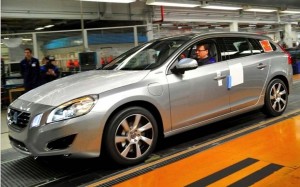Volvo Car Corp., the Chinese-owned maker of prestige Euro cars, is starting up limited production of what it describes as the world’s first diesel plug-in hybrid.
The new Volvo V60 Plug-in Hybrid can run for long periods on batteries or utilize the onboard diesel engine for power during extended driving.
The combined diesel and electric drive system produces about 285 horsepower and Volvo says it expects an average 124 miles per gallon equivalent fuel economy, a number calculated around using the battery propulsion for much of one’s daily driving.
According to Volvo, the V60 Plug-in uses an 11.2 kWh lithium-ion battery that should yield 50 kilometers – or about 32 miles — per charge. It does not appear there are near-term plans to bring the V60 Plug-in to the U.S., nor is it clear what the EPA range rating would be. The government agency – which oversees fuel economy and related testing – typically comes up with a far less generous number than manufacturers quote for themselves.
It appears that Volvo is drawing deeper into the energy stored in its battery than the competing Chevrolet Volt and its European cousin, the Opel Ampera. They manage only a few more miles per charge on a 16 kWh LIon battery, General Motors conservatively tapping only about 60% of the battery’s total energy reserves in order to maximize its life. Other makers, however, draw down as much as 90% of total energy to maximize range.
Volvo is not the first to use a diesel in a hybrid configuration, Peugeot having pioneered the pairing of the two technologies in a conventional hybrid layout.
However, “We are first in the industry to integrate a plug-in hybrid in an established production flow together with other car models,” says Peter Mertens, Senior Vice President Research and Development at Volvo Car Corporation. “The integration in the standard production flow gives the plug-in hybrid buyer the possibility to choose in principle all options available for the standard V60.”
The assembly of the diesel plug-in hybrid will take place on the same line as the company’s other models at the Torslanda plant in Gothenburg – though the line had to be modified in several places to handle the diesel-hybrid.
Among the biggest challenges, according to Volvo, was installing the lithium-ion battery pack. That requires lifting it through the car’s tailgate, says a company news release, “short side forward. It is then spun a quarter of a turn in the passenger compartment – a maneuver that takes 60 seconds and carried out with less than 20 millimeters to spare.”
In all, the new model carries 200 more parts than the conventional Volvo V60 – including the dual gas/electric drivetrain.
Volvo has not yet announced pricing for the new plug-in but considering the hefty premiums that diesels and plug-ins command individual, the price tag for the V60 Plug-in is expected to be substantial, Volvo largely targeting upscale buyers who want to go green whatever the cost.
After the initial batch of 1,000 model-year 2013 cars, production will increase to 4,000-6,000 cars in 2014, Volvo plans.
Paul A. Eisenstein contributed to this report.


“The combined diesel and electric drive system produces about 285 horsepower and Volvo says it expects an average 124 miles per gallon equivalent fuel economy, a number calculated around using the battery propulsion for much of one’s daily drivi “
“According to Volvo, the V60 Plug-in uses an 11.2 kWh lithium-ion battery that should yield 50 kilometers – or about 32 miles — per charge. “
OR,
after paying to BUY for all this MESS,
the American customer CAN open the hood,
throw all this garbage away,
and put a 100 pounds Engine IN,
like the OPOC of Bill Gates
or the ACHATES of Walmart
or the Pinnacle Engine
or some of these:
http://www.pattakon.com/pattakonOPRE.htm
http://www.pattakon.com/pattakonPatOP.htm
http://www.pattakon.com/pattakonFly.htm
to get MORE than the 124 miles per gallon,
HERE promised by VOLVO.